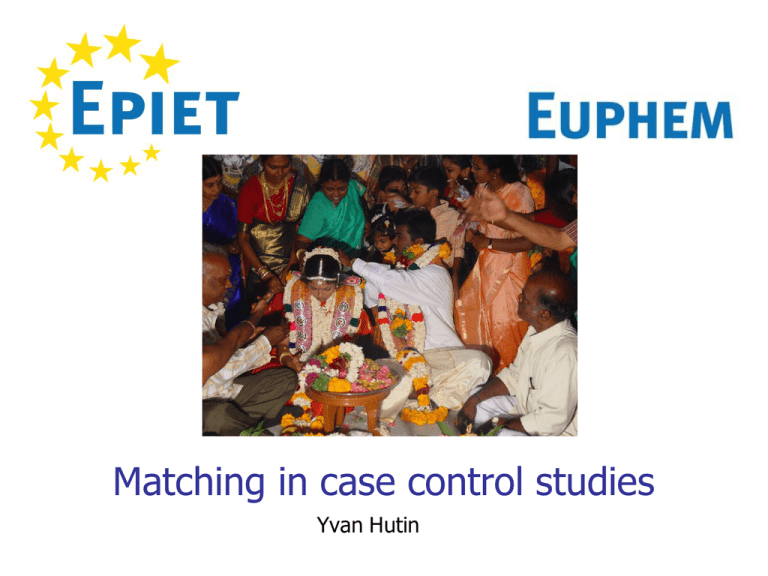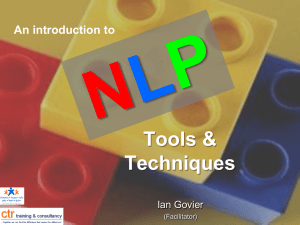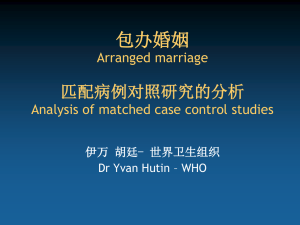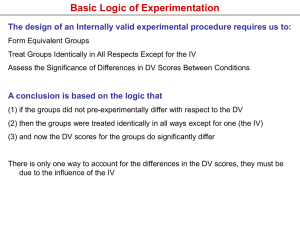
Matching in case control studies
Yvan Hutin
Cases of acute hepatitis (E) by residence,
Girdharnagar, Gujarat, India, 2008
Attack rate
per 1,000
> 40
30-39
20-29
>0-10
0
Water pumping
station
Leak
Drain
overflow
Risk of hepatitis by place of residence,
Girdharnagar, Gujarat, India, 2008
Source of water
Hepatitis
No hepatitis
Total
Leaking pipes /overflowing drain
144
8,694
8,838
No leakages / overflowing drain
89
12,436
12,525
233
21,130
21,363
Total
RR = 2.3, Chi Square= 41.1 df= 1. P < 0.001
3
Attack rate of acute hepatitis (E) by zone of
residence, Baripada, Orissa, India, 2004
Attack rate
0 - 0.9 / 1000
1 - 9.9 / 1000
10 -19.9 / 1000
20+ / 1000
Underground water supply
Pump from river bed
Case-control study methods, acute hepatitis
outbreak, Baripada, Orissa, India, 2004
• Cases
– All cases identified through active case search
• Control
– Equal number of controls selected from affected wards but
in households without cases
• Data collection
– Reported source of drinking water
– Comment events
– Restaurants
Consumption of pipeline water among acute
hepatitis cases and controls, Baripada, Orissa,
India, 2004
Acute
hepatitis
Control
Total
Drunk pipeline
water
493
134
627
Did not drink
pipeline water
45
404
449
Total
538
538
1076
Adjusted odds ratio = 33, 95 % confidence interval: 23- 47
Key elements
• The concept of matching
• The matched analysis
• Pro and cons of matching
Controlling a confounding factor
• Stratification
• Restriction
• Matching
• Randomization
• Multivariate analysis
The concept of matching
• Confounding is anticipated
– Adjustment will be necessary
• Preparation of the strata a priori
– Recruitment of cases and controls
• By strata
• To insure sufficient strata size
• If cases are made identical to controls for the
matching variable, the difference must be explained
by the exposure investigated
Consequence....
• The problem:
– Confounding
• Is solved with another problem:
– Introduction of more confounding,
– so that stratified analysis can eliminate it.
Definition of matching
• Creation of a link between cases and controls
• This link is:
– Based upon common characteristics
– Created when the study is designed
– Kept through the analysis
Types of matching strategies
• Frequency matching
– Large strata
• Set matching
– Small strata
– Sometimes very small (1/1: pairs)
Unmatched control group
Cases
Controls
Bag of cases
Bag of controls
Matched control group
Cases
Controls
Sets of cases and controls that
cannot be dissociated
Matching:
False pre-conceived ideas
Matching is necessary for all case-control studies
Matching needs to be done on age and sex
Matching is a way to adjust the number of controls
on the number of cases
Matching:
True statements
Matching can put you in trouble
Matching can be useful to quickly recruit controls
Matching criteria
• Potential confounding factors
– Associated with exposure
– Associated with the outcome
• Criteria
– Unique
– Multiple
– Always justified
Risk factors for microsporidiosis
among HIV infected patients
• Case control study
• Exposure
– Food preferences
• Potential confounder
– CD4 / mm3
• Matching by CD4 category
• Analysis by CD4 categories
Mantel-Haenszel adjusted odds ratio
OR
M-H=
ai.di) / Ti]
bi.ci) / Ti]
Matched analysis by set
(Pairs of 1 case / 1 control)
• Concordant pairs
– Cases and controls have the same exposure
– No ad and bc: no input to the calculation
Cases
Controls
Total
Exposed
1
1
2
Non exposed
0
0
Total
1
1
No effect
Cases
Controls
Total
Exposed
0
0
0
0
Non exposed
1
1
2
2
Total
1
1
2
No effect
Matched analysis by set
(Pairs of 1 case / 1 control)
• Discordant pairs
– Cases and controls have different exposures
– ad’s and bc’s: input to the calculation
Cases
Controls
Total
Exposed
1
0
1
Non exposed
0
1
Total
1
1
Positive association
Cases
Controls
Total
Exposed
0
1
1
1
Non exposed
1
0
1
2
Total
1
1
2
Negative association
The Mantel-Haenszel odds ratio...
OR
M-H=
ai.di) / Ti]
bi.ci) / Ti]
…becomes the matched odds ratio
OR
M-H=
Discordant sets case exposed
Discordant sets control exposed
…and the analysis can be done
with paper clips!
• Concordant questionnaire : Trash
• Discordant questionnaires : On the scale
– The "exposed case" pairs weigh for a positive association
– The "exposed control" pairs weigh for a negative association
Analysis of matched case control studies with
more than one control per case
• Sort out the sets according to the exposure status of
the cases and controls
Example for 1 case / 2 controls
Sets with case exposed:
+/++, +/+-, +/-Sets with case unexposed:
-/++, -/+-, -/--
• Count reconstituted case-control pairs for each type
of set
• Multiply the number of discordant pairs in each type
of set by the number of sets
• Calculate odds ratio using the f/g formula
The old 2 x 2 table...
Cases
Controls
Total
Exposed
a
b
L1
Unexposed
c
d
L0
C1
C0
T
Total
Odds ratio: ad/bc
... is difficult to recognize!
Cases
Controls
Exposed
Unexposed
Total
Exposed
e
f
a
Unexposed
g
h
c
Total
b
d
P (T/2)
Odds ratio: f/g
The Mac Nemar chi-square
(f - g)
Chi2
McN=
(f+g)
2
Matching: Advantages
Easy to communicate
Useful for strong confounding factors
May increase power of small studies
May ease control recruitment
Suits studies where only one factor is studied
Allows looking for interaction with matching criteria
Matching: Disadvantages
✘ Must be understood by the author
✘ Is deleterious in the absence of confounding
✘ Can decrease power
✘ Can complicate control recruitment
✘ Is limiting if more than one factor
✘ Does not allow examining the matching criteria
Matching with a variable associated with
exposure, but not with illness
(Overmatching)
• Reduces variability
• Increases the number of concordant pairs
• Has deleterious consequences:
– If matched analysis: reduction of power
– If match broken: Odds ratio biased towards one
Hidden matching
(“Crypto-matching”)
• Some control recruitment strategies consist de facto
in matching
– Neighbourhood controls
– Friends controls
• Matching must be identified and taken into account in
the analysis
Matching for operational reasons
• Outbreak investigation setting
• Friends or neighbours controls are a common choice
• Advantages:
– Allows identifying controls fast
– Will take care of gross confounding factors
– May results in some overmatching, which places the
investigator on “the safe side”
Breaking the match
• Rationale
– Matching may limit the analysis
– Matching may have been decided for operational purposes
• Procedure
– Conduct matched analysis
– Conduct unmatched analysis
– Break the match if the results are unchanged
Take home messages
• Matching is a difficult technique
• Matching design means matched analysis
• Matching can always be avoided






